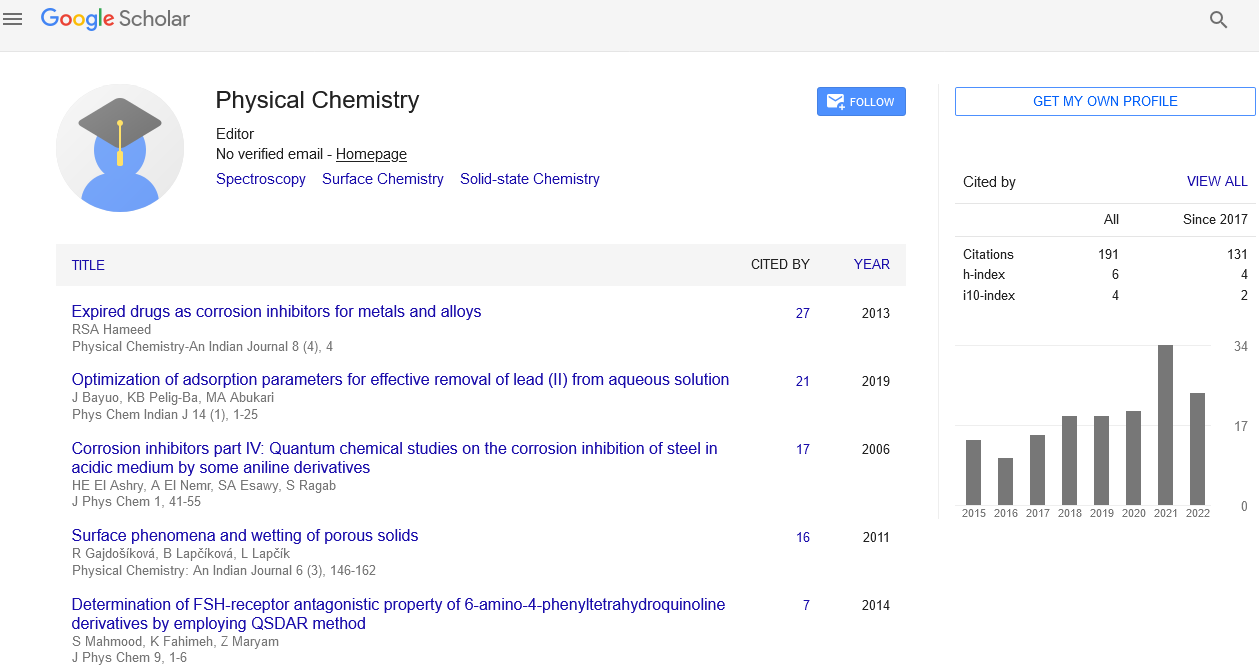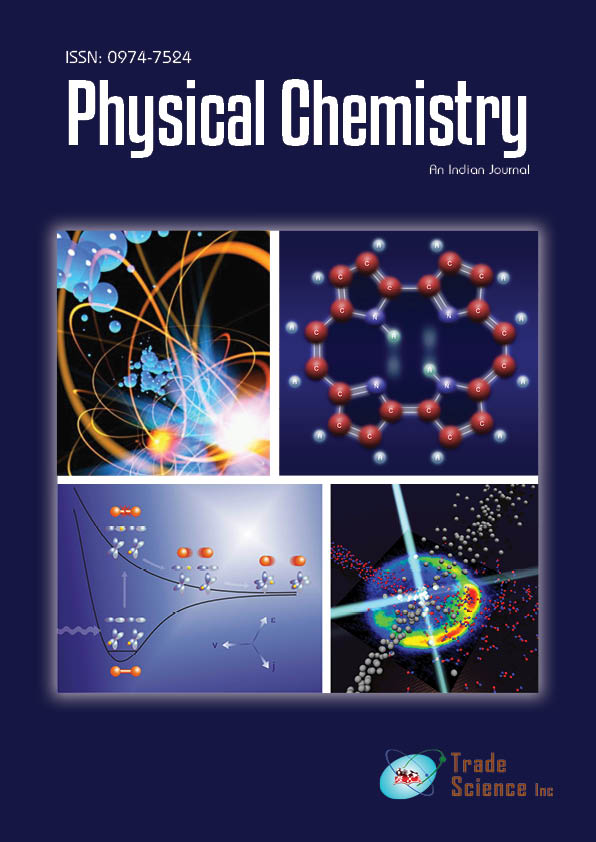Research
, Volume: 18( 1)Studies Of Effect Of Pressure On Electrical Conductivity Of Non-Stochiometry Cuprous Bromide In Solid State
Studies the Effect of Pressure on Electrical Conductivity of Non-Stochiometry Cuprous Bromide in Solid State Vimalesh Kumar Singh* Department of Chemistry, Faculty of Science, Dr. Ambedkar Govt. P.G. College Unchahar Rae Bareli Uttar Pradesh India *Corresponding author:Vimalesh Kumar Singh, Department of Chemistry, Faculty of Science Dr. Ambedkar Govt. P.G. College, India; Email: drvksinghlu@rediffmail.com Received date: June 26, 2022, Manuscript No. TSPC-22-67752; Editor assigned: June 29, 2022, PreQC No. TSPC-22-67752 (PC); Reviewed: July 13, 2022, QC No. TSPC -22-67752(Q); Revised: August 25, 2022, Manuscript No. TSPC-22-67752 (R); Published: September 05, 2022, DOI: 10.37532/ 0974-7524.2022. 17(3).167
Abstract
The electrical conductivity (d.c.) of the solid CuBr with a definite stoichiometry was determined employing cell configuration Cu / CuBr / Cu over an extensive range of pressure which allowed us to obtain the detail runs of conductivity, including the phase transformations: γ-CuBr ↔β-CuBr and β--CuBr ⇔ α-CuBr. Conductivity decreases with increases in concentration of bromide in CuBr lattice. Conductivity of CuBr, CuBr1.0018 and CuBr1.0037 are increases with increasing thickness as well as pressure. The increasing of conductivity (σ) with thickness is surprising. With available information we suggest that lower conductivity of stacked pellet of the same thickness is due to larger contact resistance in stacked pellet.
Abstract The electrical conductivity (d.c.) of the solid CuBr with a definite stoichiometry was determined employing cell configuration Cu / CuBr / Cu over an extensive range of pressure which allowed us to obtain the detail runs of conductivity, including the phase transformations: γCuBr ↔β-CuBr and β--CuBr ⇔ α-CuBr. Conductivity decreases with increases in the concentration of bromide in CuBr lattice. Conductivity of CuBr, CuBr1.0018, and CuBr1.0037 are increases with increasing thickness as well as pressure. The increase of conductivity (σ) with thickness is surprising. With available information, we suggest that the lower conductivity of the stacked pellet of the same thickness is due to larger contact resistance in stacked pellet. Keywords: Conductivity; Definite stoichiometry; Stacked pellet; Graphite coated pellet; Phase transformation Introduction The conductivity measurement of CuBr has been an important topic of research for decades [1-6]. The electrical conductivity of cuprous bromide was first studied by Friederich and Meyer, who suggested that CuBr shows metallic-type conduction [7]. Rapoport and Pistorius reported as the phase diagrams of CuBr to 40 kbar consist of three solid phases and the liquid [8]. The stability region of hexagonal CuBr is terminated at 6.1 kbar. At higher pressures, there is a direct transition from the zinc-blende structure to disordered bcc. The melting curves of the disordered bcc phases of CuBr at first rise steeply with pressure, but flatten off considerably above ∼ 25 and ∼ 30 kbar, respectively. This is ascribed to the presence of a denser species in the melt. VanValkenburg found two transitions, separated by ∼ 0.1 kbar, at 47 kbar. The phase with the narrow stability range was non-cubic, while the higher pressure form was cubic [9] . In addition, there was a transition at 80 kbar to a non-cubic form [10]. Edwards and Drickamer found two transitions at ∼ 50 kbar, separated by ∼ 2.5 kbar, and two further transitions at 80 kbar and 95 kbar. The sensitivity of conductivity with contact pressure in our sample aroused our curiosity to measure conductivity with a definite pressure. Measurement of conductivity of CuBr of definite stoichiometry with pressure does not seem to be available in literature though there are several reports on phase transition in CuBr. Jayaramann et al, reported that the phase transition of CuBr employing volumetric, conductivity, polarization, and optical techniques [11]. In their studies, CuBr has been found to have three stable phases below 20 kbar. On the basis of optical and X-rays diffraction studies, Moore et al, reported that the phase transition at 4 kbar and 5 kbar [12]. They also reported a sluggish phase at 14 kbar-30 kbar and other at 53 kbar. These transitions were later verified by resistivity measurements [13, 14]. A relevant review of the literature reveals that significant work has been done on the structural and transport properties of solid and molten CuBr in order to analyze the structure and ionic motion in different phases [15-21]. However, some detailed experimental data are still desirable. Cuprous halides are interesting from both scientific and technological points of view. Moreover, economically, copper compounds might be a good alternative to silver conductors. Since, the use of CuBr for the fast ions electrolyte, due to highly mobile cuprous ions is getting popularity and this material also seems to possess Research www.tsijournals.com | August 2022 July-2022 2 Super Ionic Conductivity (SIC), it has its importance both academically as well as technically. Hence, the conductivity of CuBr in a low, as well as high-pressure region, including the phase transition -phase ⇔ β-phase, β-phase ⇔ α-phase, was studied in the present work. Experimental method Sample preparation Cuprous bromide was prepared by treating solutions of copper sulphate-AR (Sigma) with sodium bisulphite-AR (Sigma) and potassium bromide-AR (Sigma) with continuous stirring. This solution was poured into a large beaker containing double distilled water. Cuprous bromide was precipitated and settled down. The solution of supernatant liquid in the beaker was decanted. The solid mass remaining in the beaker was rinsed with water and acetone at least 3 times to 4 times to remove as much cupric bromide and other impurities from the solution till the supernatant liquid was almost colorless. Cuprous bromide was vacuum filtered with the help of a Buckner funnel and washed with acetone and absolute alcohol while filtering. Cuprous bromide after the filtration was dried at 50°C in a vacuum oven for 10 hours and was stored in a vacuum desiccator for use. Before conductivity measurements, the product obtained was probed by Scanning Electron Microscopy (SEM), X-Ray Diffraction (XRD), and Electron Paramagnetic Resonance spectroscopy (EPR) methods. Procedure for measuring conductivity as a function of pressure and thickness Spherical bright copper electrodes (diameter-1.72 cm, thickness 1 mm, and area 2.32 cm2 ) washed with AR acetone and dried at 40? were employed. A2 mm thick pellet was sandwiched between two copper electrodes in order to give the cell configuration Cu/CuBrx/Cu. This cell was loaded in a pressure machine (MTS model No. 810.12) through which variable pressure can be applied. The electrodes were connected with a digital conductivity meter HP 3457A model. The schematic diagram of the conductivity measuring assembly is shown in FIG. 1. Before applying additional pressure, measurements were made when the electrodes were just touching the pellet. This value was considered as conductivity at contact pressure. The value of external pressure was gradually increased and a corresponding change in conductivity was recorded. For thick pellets (4 mm and 6 mm) the same procedure was adopted for measuring conductivity. In some runs, pellets were damaged but such data were excluded and only those samples which did not break were taken into account for reporting conductivity data. The same procedure was adopted for measuring the contact resistance between the electrode and pellet of CuBr. FIG. 1. Circuit diagram for conductivity and current measurement. Result and Discussions Characterization The CuBr used in this investigation has been characterized based on the impurity present in it. Only Cu++ impurity has been taken into account since Cu++ is only an inorganic cation which is likely to play an active role in the transport properties of CuBr. Transport property is the intrinsic property of CuBr material and effective only when an impurity atom (bromine atom) enters into the lattice (of a given crystalline material) or produces any perturbation to the lattice by making an electron deficient bond in the crystal lattice. A scanning electron microscopy (SEM) image of the cross-sectional cell structure is shown in FIG. 2. www.tsijournals.com | August 2022 July-2022 3 FIG. 2. SEM images of CuBr crystals: (a and b) synthesized CuBr, (c-f) standard CuBr. A room temperature, X-ray powder diffraction pattern is shown in FIG. 3 and FIG. 4 resemble well to that of the CuBr. The XRD patterns observed are in good agreement with the literature value of CuBr and the observed peaks can be attributed to the cuprous bromide phase. The Bragg diffraction patterns of the CuBr and CuBr1.0018 samples showed (FIG. 3, FIG. 4) the cubic zincblende structure with lattice plane oriented along (111), (220), and (311). For CuBr, the most intense peak corresponds to the centered at 27.12 , while two other relatively less intense peaks correspond to the centered at 45.03 and 53.36 whereas in CuBr1.0018, the most intense peak corresponds to the centered at 27.00 , while two other relatively less intense peaks correspond to the centered at 44.90 and 53.24 . From the literature it is observed that the X-ray diffraction pattern was found to be in good agreement with the CuBr patterns, indicating that the cuprous bromide is present as the phase at room temperature. A comparison between the experimental and the literature-reported X-ray diffraction peak position and intensities shown are in TABLE 1. TABLE 1. A comparison of experimental and reported X-ray diffraction peak positions and intensities for CuBr. Phase Literature data for CuBr (Suyal et al 2003) Experimental data 2? Intensity Sample 2? Intensity 111 27.12 100 CuBr 27.117 100 45.025 34.01 220 45.02 50 53.356 17.45 CuBr1.0018 27.001 99.5 311 53.34 35 44.9 44.5 53.24 34.5 www.tsijournals.com | August 2022 July-2022 4 FIG. 3. Plot illustrating the XRD pattern of -CuBr. FIG. 4. Plot illustrating the XRD pattern of -CuBr1.0018. EPR signals were not observed in CuBr as evidenced from the EPR spectra FIG. 5 indicate the presence of Cu+ in the sample. In stoichiometric cuprous bromide crystal, Cu+ ion and Br- ion have the configuration 3d10 4s0 and 4s2 4p 6 , respectively. In the present sample of CuBrx excess bromine atoms are incorporated into a cuprous bromide lattice. Consequently, bromine atoms would interact with the electron of Cu+ ion, as if Cu is converted to Cu++ having 3d9 4s0 configurations. This configuration creates an electron deficiency in copper of CuBrx. This deficiency in copper acts as a positive hole in CuBrx crystal which is likely to play an active role in the transport properties of CuBr.

